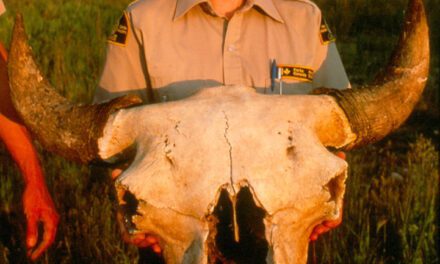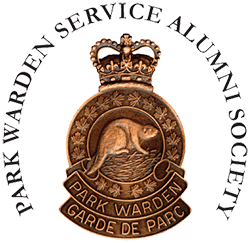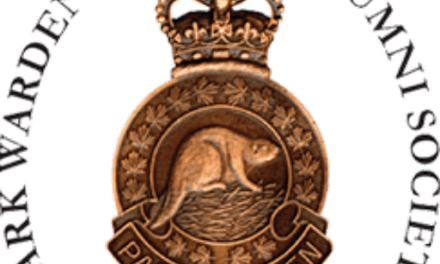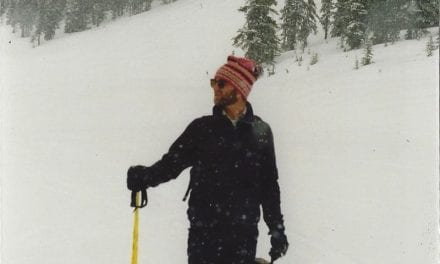This Oral History interview was funded in part by a research grant received in 2021 from the Government of Alberta through the Alberta Historical Resources Foundation.
Park Warden Service Alumni Society of Alberta
Oral History Project Phase 11 – Spring 2021
Telephone Interview with Ian Pengelly
May 6, 2021 – 11:00 am
Interviewed by Susan Hairsine
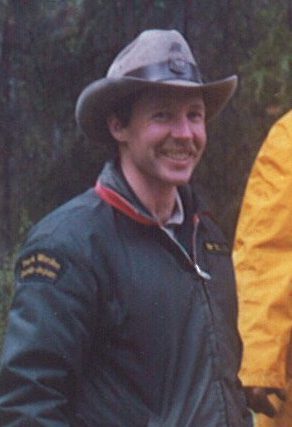
Place and date of birth?
Ian was born in Elnora, Alberta which is in the central part of the province east of Red Deer, on September 30, 1951.
SH: Where did you grow up?
Ian: I grew up nearby in the town Delburne. I finished high school in 1970 and my first job out of high school was driving tour boats at Maligne Lake. That was my introduction to living in the mountains and I got interested in the history of exploration of the Rockies. I started doing backcountry hiking and so on. Eventually I was exposed to some of the wardens and what they did, and I became interested in becoming a park warden. At the time the entry requirement was 2 years of post secondary schooling so I started school at the University of Calgary hoping to get a seasonal warden position.
SH: How did you become involved in the Warden Service? Which national park did you start working in?
Ian: I applied for a job as a fire lookout but I ended up getting hired as a term warden in 1973. I did term jobs in Kootenay Park and Jasper until I became a seasonal park warden in Pacific Rim in the spring of 1976.
SH: So Jasper was your first national park?
Ian: Yes
SH: What made you want to join the Warden Service?
Ian: I couldn’t really see myself working in the city … in an indoor city job. The warden job seemed to be interesting and outdoors. It was just a lifestyle choice.
SH: What different parks have you worked in, how did they compare, and do you have a favorite?
I worked in Jasper, Kootenay briefly, Pacific Rim, Rev/Glacier and Banff. A lot of my early jobs were in pretty remote places: Port Renfrew, Rogers Pass, Kootenay Crossing. When I moved to Banff it was for a permanent job. I liked that it had a nice combination of remote backcountry and some amenities in the town of Banff, and Calgary.
SH: So Banff was your favourite? (Tape 3:38)
Ian: I enjoyed Pac Rim and Glacier for the seasons I was there, but I wasn’t really interested in a year round job in those places. While I was moving back and forth between the West Coast Trail and Rogers Pass, for four years, I really enjoyed both of those places.
SH: What were some of your main responsibilities over the years?
Ian: Well the first half of my career was as a park warden and doing everything within the scope of that job. Pacific Rim was primarily providing information to people hiking the West Coast Trail, developing trail guides, rescuing people, doing various things in the community for their fish hatchery ….. things like that. Then Banff was a mixture of backcountry patrols in summer and winter, avalanche control at the ski areas, fisheries work at Lake Minnewanka, and law enforcement in the campgrounds and on the boundary.
SH: So you were definitely a generalist warden for a good chunk of your career, so when did you become more involved in the fire program in Banff?
Ian: I started working with Tim LaBoucane in 1989 and at that time, the Warden Service in Banff was in transition. By 1993 the classification and education requirement changed. I had to go back to school to finish my degree at the U of C. But even then the job was quite broad because it involved fire suppression, prescribed burning, fuels management, mountain pine beetles, weeds, a bit of a research program. And there was still backcountry travel on skis, horse and foot. Although it became what was known as a specialist job in Banff Park, with the provincial agencies that I interacted with, I was still very much a generalist.
SH: The best of all worlds.
Ian: Perhaps. That was what had attracted me to the job in the first place and I tried to maintain a wide range of duties as much as I could. (Tape 7:30)
SH: What did you like about being a Warden? What didn’t you like about being a Warden?
Ian: Initially there was a fair amount of independence. On the West Coast Trail I was my own boss, and again in the backcountry. It was up to you and what you did and where you did it and how you structured your time. I also enjoyed working with other people in the office that had different duties and different education. You had people like John Nylund and Tim Auger who were specialists in their field and you could always learn something just from hanging around with them and traveling with them from time to time.
SH: What didn’t you like about being a warden? I liked the line about getting paid two or three times more.
Ian: I wish I got paid two or three times more. But seriously, I found that living in Banff it was difficult to get away from the job. Every visit to the dentist, doctor, post office and grocery store could turn into a discussion of park management with one of the locals. Moving to Canmore provided some separation between work and private life.
SH: Good answer.
What are some of the more memorable events of your Warden Service career?
Ian: A couple of things that stood out in Banff were searches, particularly the one for a guy called Ferris that was lost near Bow Summit. It came down to him being found and rescued within minutes of a major storm that would have halted the search for a few days. There was also a hiker with four dogs that got lost near Badger Pass and he was found in pretty tough shape. So those were a couple of memorable searches.
There was a few events on the West Coast Trail that are long to describe so I’ll send you some notes on those. Here are some of those stories:
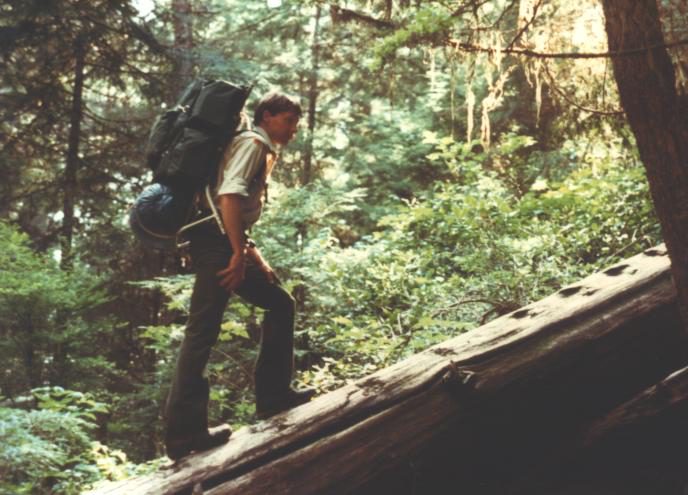
Boating at Night
Lou Tremblay had a house that faced the bay, was a night owl and always kept one eye on the water. One night she phoned me about 11 pm. “There is a big fire on the beach at Thrasher Cove, maybe someone is in trouble” she reported. Ron Tessolini, the warden from the Broken Group Islands was staying with me so we got the zodiac ready and headed out over the river bar. There was just enough water to get across, the propeller kicking up a bit of gravel.
There were a few things to watch out for when leaving or arriving home in the dark. One hazard was a deadhead in the river channel that was hard to see but easy to hit, another hazard was when the incoming swell broke on the bar at the mouth of the river, and the third was missing the river channel and ending up in the surf breaking near the beach. This was not so difficult when leaving the river and heading out into the bay, but it was much more difficult to find the river channel when coming in off the ocean in the dark. In the days before GPS and chart plotters we had to navigate by using the lights from town, travelling back and forth across the bay until the lights seemed to be lined up in the right position. It was easy to miss the river mouth and end up in shallow water one side or the other.
We arrived at Thrasher Cove and saw a fellow standing beside a huge fire. I shut off the engine, without landing on the beach. “Is there a problem there?” I shouted. “No” he said, “I am just weary of the trail and would like to get out of here today if I could” I unleashed a stream of curses at him for dragging us out there for no good reason, started the engine and headed home.
On another occasion, I arrived home after fishing near Owen Point. It was nearly dark and raining hard. A young German hiker stepped out from the shelter of the house and said. “Can you help my friend? I left him on the trail near Camper Bay, he was too exhausted to travel any further.” The stronger of the two hikers had carried on to Thrasher Cove, caught the ferry from there to Port Renfrew and then run to the house. “What does your friend have for camping gear?” I enquired. “Well, that’s the problem, you see I was in a such a hurry to get help that I forgot I was carrying our tent!” I cursed quietly and said, “Well it’s pitch black out there – there’s nothing I can do about it now!” More pleading ensued and finally I relented and started getting ready for the rescue mission.
Navigating at night posed a number of challenges at the best of times, but the heavy rain now blotted out all light from the sky and the water was inky black. I headed out and I was able find the whistle buoy at the entrance to Port San Juan. From there I then turned onto the course that would take us up the coast and followed this until I felt I had gone far enough to clear Owen Point. Then I turned at a right angle and ran directly toward the coastline until I was able to see a faint white line where the swells were breaking on the rocks. Then we turned up the coast again and crept along just off shore. Finally, I saw where the white line of surf also had a vertical streak – indicating the waterfall at Tristle Creek, about 1 kilometer from Camper Bay. We soon landed on the beach at Camper Bay without any problems and walked up river until we were directly across from the campground. The river was swollen with runoff and we could not get across to the campground. We did however, wake up the campers and found that someone had taken pity on him and given him a place to sleep in their tent.
By now it was nearly midnight and I knew that when the tide was high around 6 am the river would be backed up by the ocean and we could easily boat over the bar and right up to the campground. I told the stranded camper to expect us at 6, and returned to Renfrew, arriving home close to 2 am. It was a short night, and the German was none too eager to get out of bed at 4 am. I didn’t really need him but dragged him along anyway. We picked up his friend, none the worse for his experience and soon I had the pair of them back in Renfrew where I fed them breakfast and sent them on their way.
A New Outboard Motor For Me, Sour Grapes For Ron Tessolini. – 1980
